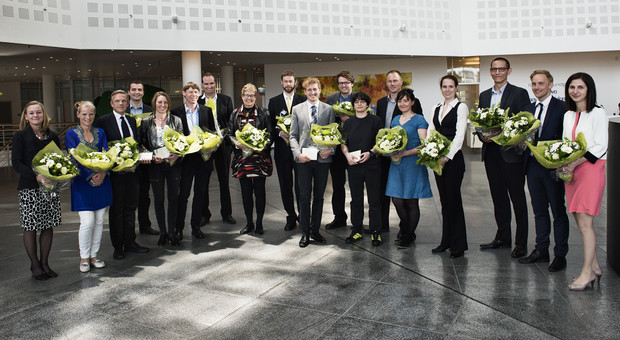The Novo Nordisk Foundation has just awarded DKK 83 million in grants to 18 researchers within the medical sciences and biotechnology. The grants were presented to the awardees at a celebration at the Novo Nordisk Foundation on Tuesday April 28, 2015.
The research projects span a wide range of topics within biomedicine and biotechnology, such as research on muscle plasticity, bacteria-based chemical factories and perinatal depression, including how to identify women at risk.
The 18 fellowships awarded include 4 postdoctoral projects focusing on cancer, with 3 of these researchers travelling to well-known institutions abroad in search of new knowledge on cancer. These include Beatrice Dyring-Andersen, who will be studying skin cancer at Harvard Medical School in Boston and Rasmus Damtoft Siersbæk, who will be studying breast cancer at the University of Cambridge. In Denmark, Elisabeth Assing Hvidt will continue her work in the Research Unit of General Practice at the University of Southern Denmark in Odense, where she will be working on communicating with people with cancer on existential problem-solving.
Pétur Heidarsson is making a somewhat different journey from the Department of Biology of the University of Copenhagen to the University of Zurich, where he will be studying unstructured complexes: researching a new world of protein interactions. The fact that up to 40% of all proteins carry out their function despite having no fixed structure became apparent recently. This has led to a paradigm shift in structural biology, and thoroughly understanding the activity of these proteins is crucial because they are extremely important in highly regulated processes in cells and are prominent in several diseases such as cancer.
All the recipients received their scholarships based on the applications submitted and were selected by the Novo Nordisk Foundation’s scientific committees, whose members are researchers and experts within their respective fields.
The scholarship recipients were honoured and briefly summarized their research at a ceremony at the offices of the Novo Nordisk Foundation.
The 18 scholarship recipients and their research projects:
4 EXCELLENCE PROJECTS

Simona Chera, PhD,
Department of Clinical Science, Faculty of Medicine and Dentistry, University of Bergen
PROJECT TITLE
“Characterizing and reversing β-cell senescence and proliferation quiescence in monogenic diabetes”
Diabetes mellitus is a group of metabolic diseases defined by high blood sugar values caused by the inability of the body to produce and/or use insulin. All forms of diabetes are ultimately characterized by a decrease to an insufficient number of functional insulin-producing cells (β-cells), hence a cure for insulin-dependent diabetes types will require their regeneration or replacement. Generally, the most efficient regenerative strategies are the ones involving cell self-renewal capacity. Nevertheless, the β-cell regenerative capacity is very low after birth and decreases even further with age. To enhance their regenerative potential, the overall aim of this project is to elucidate and reverse the molecular age-switch controlling the gradual impairment of β-cell self-renewal capacity by using two mouse models of monogenic diabetes.

Thomas Eberhardt Jensen, Associate Professor
Department of Nutrition, Exercise and Sports (NEXS), University of Copenhagen
PROJECT TITLE
“Understanding skeletal muscle plasticity in health and disease”
Inactivity, ageing and a range of diseases are associated with a detrimental loss of skeletal muscle mass. The intracellular signaling molecule mammalian Target Of Rapamycin Complex 1 (mTORC1) is a key controller of muscle growth, but its exact molecular regulation is still poorly understood. To better understand mTORC1 regulation and function in rodent and human muscle, this project will use methods ranging from newly-developed mass spectrometry to discover novel mTORC1-relevant signaling mechanisms to state-of-the-art microscopy in live mice, to study when and where mTORC1 signals in the intact muscle cell. This research may ultimately identify novel drug or gene manipulation targets to beneficially alter skeletal muscle growth, as part of prevention or treatment strategies for human disease.
Marcus Lind, Associate Professor
NU Hospital Group, Uddevalla, Sweden, the University of Gothenburg, Gothenburg, Sweden
PROJECT TITLE
“Type 1 diabetes and mortality”
It has recently been found that individuals with type 1 diabetes still have an increased risk of mortality. This project aims to further understand the reasons for the increased risk and to reduce the risk. We will evaluate excess risk of cardiovascular complications and early death using registry data. We will also use echocardiography to see if early signs of heart failure can be detected. Independent trials of continuous glucose monitoring will evaluate accuracy and treatment experience being essential in preventing acute complications. A randomized trial with visits to a diabetes educated psychologist will be performed to determine if this can help patients with high glucose levels.
Sofia Movérare Skrtic, Associate Professor
Centre for Bone and Arthritis Research, Department of internal medicine and clinical nutrition, Sahlgrenska Academy, University of Gothenburg
PROJECT TITLE
“WNT16 – a Novel Regulator of Cortical Bone and Non-Vertebral Fracture Risk”
Sweden and Norway have the highest incidence of bone fractures in the world. Currently available osteoporosis drugs are effective in reducing vertebral fracture risk (mainly dependent on trabecular bone mass) while they are less effective in reducing non-vertebral fracture risk (mainly dependent on cortical bone mass) and most fractures actually occur at non-vertebral bone sites. Our recent human genetic studies demonstrate that the WNT16 locus is unique in being associated with cortical bone mass and non-vertebral fracture risk. We hypothesize that WNT16 might be a promising drug target for fractures at cortical bone sites. The overall aim of this proposal is to characterize how WNT16 regulates cortical bone mass. This project will increase the knowledge of the regulation of cortical bone homeostasis and might open novel avenues for specific prevention or treatment of non-vertebral fractures.
4 POSTDOC FELLOWSHIPS FOR RESEARCH ABROAD

Pétur Heidarsson, Postdoctoral Research Fellow
Ben Schuler Laboratory, Department of Biochemistry, University of Zurich, Switzerland
Department of Biology, University of Copenhagen
PROJECT TITLE
“Disordered complexes: exploring a new realm of protein interactions”
The abundance of functional proteins that lack stable three-dimensional structure and the complexity of their interactions is increasingly being realized. Such proteins can interact and form disordered complexes where one or both partners remain unstructured, which represents a novel yet sparsely described phenomenon in structural biology. Given the enrichment of disorder within signaling and cancer-related proteins, deciphering the molecular basis for these unorthodox interactions will be vital for future drug targeting strategies. This project is intended to study in detail the mechanism of disordered complex formation during gene regulation, with advanced techniques capable of resolving individual molecules, even within living cells. Understanding the functionality of dynamic, heterogeneous protein complexes has the potential to alter both our perception of protein interactions and our ability to modify them, with enormous future prospects for human health treatments.
Jesper Bonnet Møller, Postdoc
Jill Roberts Institute for Research in Inflammatory Bowel Disease – Weill Cornell Medical College – Cornell University, New York og Department of
Cancer and Inflammation Research, University of Southern Denmark
PROJECT TITLE
“The role of the novel chitin receptor FIBCD1 in inflammatory bowel disease and helminth infections.”
The aim of this research is to characterize the protein FIBCD1 in inflammatory bowel disease (IBD) and helminth infections. Though the use of advanced animal models of intestinal inflammation and helminth infections we aim to answer the following: How does FIBCD1 ameliorate one type of IBD while FIBCD1 exacerbate other types of intestinal inflammation? Does FIBCD1 play a role during helminth infections? And does helminth infections due to the presence of FIBCD1 influence the severity of IBD? Collectively, we expect our studies will answer key questions that relate to the so-called “hygiene theory” – a theory linking the lack of helminth infections to the increasing incidence of IBD observed in modern societies. Moreover, we expect our studies to define the functions of FIBCD1 with regard to intestinal immunity, which thereby may open new directions for treatment of the increasing number of patients.
Beatrice Dyring-Andersen, MD, PhD
Harvard Skin Disease Research Center, Harvard Medical School, Boston
Dermato-allergologisk Afdeling, Gentofte Hospital
PROJECT TITLE
“The role of IL-9 in antitumor protection in human skin cancer”
Malignant melanoma is a highly aggressive skin cancer and more effective therapies are needed. IL-9 is a cytokine produced by human immune cells such as T cells and may serve as an amplifier of inflammation. IL-9 has never been studied in human cancer for its ability to enhance antitumor responses. We will study IL-9 in primary and advanced stage human malignant melanoma and determine if increased IL-9 levels are associated with better tumor immunity.
We will determine if IL-9 levels correlate with better survival in malignant melanoma patients. This work is also highly clinically relevant. If our hypothesis is correct, about the role of IL-9 producing T cells in cancer, then the implications for cancer therapy – from adoptive transfer of T cells producing IL-9 to agonists of the T cell IL-9 receptor – are equally as important.
Rasmus Damtoft Siersbæk, Postdoc, PhD
Cancer Research UK (CRUK), Cambridge Research Institute, University of Cambridge, Cambridge
Department of Biochemistry and Molecular Biology, University of Southern Denmark, Odense
PROJECT TITLE
“Molecular mechanisms of estrogen receptor function in endocrine resistant and metastatic breast cancer”
Breast cancer is the most common type of cancer affecting women with around 4,500 new cases in Denmark every year. A protein termed the estrogen receptor is found in most breast cancers, and recent evidence suggests that it plays an important role during progression of the disease, i.e. development of resistance to endocrine therapy and formation of metastases. This project aims to delineate the molecular mechanisms through which estrogen receptor function is altered in advanced stages of breast cancer. This will provide novel molecular insight into breast cancer progression as well as reveal new potential clinical opportunities for intervention.
2 POSTDOCTORAL FELLOWSHIPS IN GENERAL PRACTICE AND FAMILY MEDICINE

Elisabeth Assing Hvidt, Postdoc
The Research Unit for General Practice, Odense, University of Southern Denmark
PROJECT TITLE
“Communication about existential concerns with cancer patients in general practice – how can it be qualified?”
Patients facing a serious cancer illness experience numerous existential and spiritual concerns that are linked with negative physical and psychological health outcomes. Past research studies have shown that many patients want their general practitioner to address their existential and spiritual concerns. In practice however, many physicians avoid discussing these topics and report several communication barriers such as insecurity and lack of formal training.
The aim of this study is to develop an effective training programme qualifying patient-centred communication about existential and spiritual issues thereby leading to increased physical and psychological wellbeing of patients.
Ruth Kirk Ertmann, Postdoc
The Research Unit for General Practice, University of Copenhagen
PROJECT TITLE
“Postnatal depression – Identification of pregnant women at specific risk in general practice.”
Depression during pregnancy or as a newly delivered mother can sometimes be serious the women and for the mother-infant relationship and are associated with increased risk of psychological and developmental disturbances in Children.
Despite a comprehensive antenatal examinations program at the GP and the midwife, the symptoms of postnatal depression are often overlooked. There may be several reasons for this: 1) The pregnant woman does not communicate that she is worried and sad. 2) The GP does not ask about this, as she is focused on completing the comprehensive biomedical pregnancy health record. 3) A problem issue overlooked by the GP, as she does not know the diagnostic frequency of postnatal depression. These circumstances can be changed, if we develop an instrument which identifies pregnant women at increased risk of developing antenatal depression to be used at second and third antenatal examination and at 8 weeks postpartum.
2 HALLAS-MØLLER INVESTIGATOR GRANTS

Jesper B. Andersen, Associate Professor
Biotech Research and Innovation Centre (BRIC), University of Copenhagen
PROJECT TITLE
“A role for aberrant miRs in inherited drug resistance: Tumor heterogeneity and novel compensatory pro-tumorigenic mechanisms in liver cancer”
Biliary tract cancer is a highly metastatic type of liver tumors with no current effective treatment. At the time of diagnosis more than 70% of patients present locally advanced or metastatic disease thus, curative surgical resection is not an option. The molecular mechanisms driving tumorigenesis and the basis for the inherited drug resistance are unclear. This work will focus on the ability of small non-coding RNA species (miRs) to regulate multiple genes and thus, orchestrate deregulated signaling networks, linking miRs to tumor heterogeneity as well as their ability to facilitate key steps in control of compensatory pathways in drug resistance. This study emphasizes the importance of understanding miR-driven tumor heterogeneity to identify novel mechanisms independent of genetic alterations, which represent candidates for drug targeting.
Sebastian Marquardt, Assistant Professor
Plant and Environmental Sciences (PLEN), University of Copenhagen
PROJECT TITLE
“Functional dissection of long non-coding RNA (lncRNA) transcription”
Genomes of complex organisms are large but only a fraction of their DNA codes for proteins, a well understood transmitter of genomic information in cells. The DNA that does not code for proteins (non-coding DNA) is converted on a large scale into mysterious long non-coding RNA (lncRNA) molecules. Despite abundant lncRNA production it is not clear how this is functionally important. My proposal focuses on characteristics of lncRNA production common to a wide range of organisms to elucidate the core concepts underlying lncRNA biogenesis and function. My functional dissection of non-coding sequences promises to discover novel paradigms of organizing genomic information.
4 CLINICIAN SCIENTIST FELLOWSHIP

Henrik Sengeløv, Chief Physician, DMSc
Department of Hematology, Copenhagen University Hospital
PROJECT TITLE
“The role of gamma/delta T cells in immune reconstitution after bone marrow transplantation and intensified treatment of graft versus host disease.“
During a bone marrow transplant, the donor immune system is transferred to the patient, and the principal immune cells, the T cells, subsequently kill the patient’s cancer cells. Unfortunately, the donor T cells may also attack the normal cells in the patient, resulting in graft versus host disease, which may progress deadly. We will investigate the nature and activation of donor T cell subtypes after transplantation, especially when graft versus host disease is present. In patients suffering from graft versus host disease, we will treat donor T cells with a combination of antibodies and ultraviolet light. The data from this project may outline procedures for donor T cell sorting before transplantation, and optimize treatment of graft versus host disease.
Ellen-Margrethe Hauge, Chief Physician, ph.d.
Reumatologisk Afdeling U, Aarhus University Hospital
PROJECT TITLE
“Early diagnosis of joint destruction in rheumatoid arthritis”
Rheumatoid arthritis is a common autoimmune disease, which destroys the joints. Treatment with low-dose chemotherapy will control the disease in most cases, but in one of four patients the treatment will fail. It is important to correctly identify these patients at an early disease state. Blood tests and X-ray examinations are not sufficient, and magnetic field (MRI) scanning is expensive as well as time consuming. We will investigate, whether a new and quick X-ray (CT) scanner with high resolution can show the early joint lesions that are too small to be identified in ordinary X-ray examinations. We have experience in the field from ongoing investigations and an international collaboration.
Per Ovesen, Chief Physician, DMSc
Department of Gynecology and Obstetrics, Aarhus University Hospital
PROJECT TITLE
“Obesity and Diabetes in Pregnancy. The Effect on Pregnancy Outcomes and Mother and Child’s Lifetime Risk of Obesity and type 2 Diabetes.”
The global obesity and diabetes epidemic results in an increase in the proportion of obese and diabetic women of reproductive age. In the last decades the concept of ‘fetal programming’, a process whereby a stimulus of the fetus confers enhanced susceptibility to postnatal disease, is increasingly recognized. Fetal programming may underlie the increased risk of obesity, which is observed in new born children (macrosomia) of obese and or diabetic mothers. More importantly there are data to suggest that obesity in childhood prevails in adulthood. The potential benefit of specific dieting and physical activity as prevention/interaction during pregnancy in obese and diabetic women will be investigated. Given the fact that childbearing women are very motivated, pregnancy is well suited for lifestyle modification. Thus, obstetricians are in a unique position to favorably impact on the health of both mother and child via preventive measures.
Data from the studies are expected to translate into evidence based recommendations regarding diet and physical exercise in pregnancy. The hope is that these recommendations may reduce pregnancy and childbirth complications as well as the risk of macrosomia. This, in turn, may reduce the number of overweight children and obese adults.
Ulla Feldt-Rasmussen, Professor, Chief Physician, DMSc
Medical Endocrinology, Copenhagen University Hospital
PROJECT TITLE
“Tailored optimization of diagnosis and treatment of classical endocrine disorders in health and disease.”
Aim of the projects are to tailor diagnosis and treatment of classical endocrine diseases to benefit general health and quality of life. Treatment with glucocorticoids has many side effects, one of which is reduction of ones own production. This life-threatening side effect may be due to genetic factors, which will be tested.
Abnormal hormone concentrations are often described as disease in other conditions e.g. traumatic brain injury and thyroid function in pregnancy. This puts a new demand on distinguishing disease from health, which is important to avoid unnecessary overtreatment.
Finally, some environmental endocrine disrupting chemicals are suspected of affecting both thyroid function, the immune system and appetite regulation, the mechanisms of which we have a unique possibility to study in cellular experiments, and thus participate in the international debate.
2 POSTDOCTORAL FELLOWSHIP FOR RESEARCH WITHIN BIOTECHNOLOGY-BASED SYNTHESIS AND PRODUCTION

Amelia-Elena Rotaru, Postdoctoral Research Fellow
Department of Biology, University of Southern Denmark, Odense
PROJECT TITLE
“Microbial Chemical Plants: Harnessing microbial metabolism for the production of valuable chemicals”
The project is about recuperating excess renewable electricity as useful chemical commodities, using microorganisms as catalysts. We intend to generate valuable chemicals like biofuels, animal feed, and plastic precursors using biogas as CO2 source for the microorganisms, while providing electrons from renewable-energy powered electrodes. The project is grounded on recent developments in microbial electrosynthesis and intends to find strategies for green production of useful chemicals from renewable resources, hereafter touching upon three major legs of the Novo Nordisk call: the use of biological tools for making valuable products, improvement of the production potential in microorganisms, improvement of raw/renewable material utilization. Microbial electrosynthesis from biogas will be studied in Clostridium ljungdahlii, a versatile acetogenic bacterium. Chemical production in Clostridium will be improved using genetic engineering, nano-engineering and removal of inhibitory by-products with the help of microbial partners. Furthermore, C. ljungdahlii will be metabolically engineered to produce desired value-added chemicals by implementing new metabolic pathways. The novelty of our approach lies in nano- and genetic- engineering of Clostridium cell-surfaces to increase electron transfer from electrodes to microorganisms; and the use of synthetic consortia to sway electron flow towards production of desired chemicals. This is the first time these methods will be used to improve conversion of biogas to valuable chemicals.
Christian Bille Jendresen, Postdoc
The Novo Nordisk Foundation for Biosustainability, Technical University of Denmark and Massachusetts Institute of Technology (MIT).
PROJECT TITLE
“Biological synthesis of charged compounds for novel functional polymers”
A large part of the chemical industry is the production of polymers, and novel polymers are desired by industry for the production of e.g. novel adhesives, thermoplastics, fuel cells and membrane. There is furthermore a growing need for a more sustainable production of polymers from renewable resources. These two needs can be satisfied if the precursor molecules for polymers can be biologically synthesized, allowing introduction of novel functionalities. Production takes place in containers holding engineered microorganisms, wherein a network of specific enzymatic reactions catalyzes the synthesis of the desired compounds from a biological carbon source. The required synthetic genes and the control elements will be designed with computer assistance, chemically synthesized and assembled before being integrated into the microorganism.



















